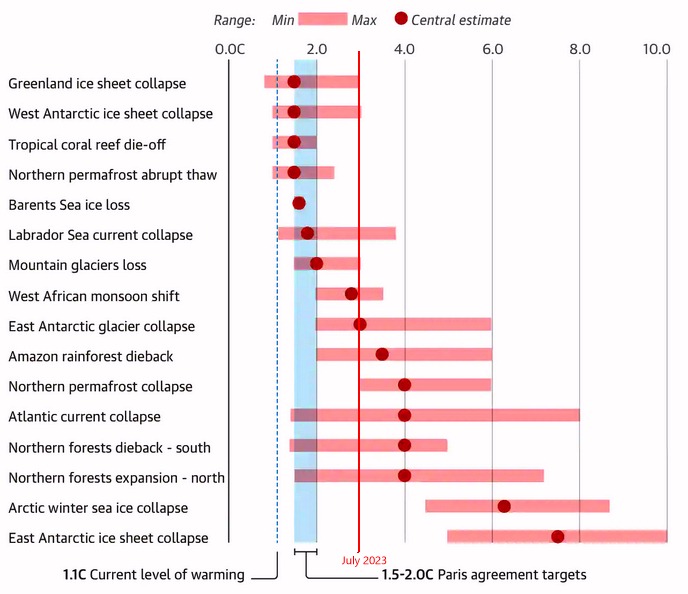
Modified from "Exceeding 1.5℃ global warming could trigger multiple climate tipping points" (Sept. 2022)
In the 1990's, the Membrane Domain started publishing research on human induced climate change. The research team was the first to put forth the hypothesis that global warming is an exponential phenomenon. Up to that point, the scientific community had based their forecasts on a linear event. The Membrane Domain suggested the model was more like a bathtub curve or hockey stick curve.
Since that time, the hypothesis has been proven. One of the main factors are chain reactions that are caused by the result. The chain reactions have been given the name "feedback loops".
"Feedback in general is the process in which changing one quantity changes a second quantity, and the change in the second quantity in turn changes the first. Positive feedback amplifies the change in the first quantity...." (Wikipedia)
An example of a feedback loop is the melting of Arctic sea ice. Methane, one of the most severe greenhouse gases, is trapped under the ice. However, when global warming causes the sea ice to melt, methane is released. When methane is released it intensifies global warming, resulting in more ice melting. In turn, more methane is released causing an acceleration in global warming... and so on.
The Arctic has multiple feedback loops including: enhanced oceanic heating and ice-albedo feedback due to diminishing sea ice, Planck feedback, lapse-rate feedback, and cloud feedback. Sea ice reflects much of the heat. Dark ocean surface absorbs more heat. The warmer temperature melts more ice resulting in warmer ocean temperatures which in turn melts more ice. A study published in the journal Nature found The Arctic has warmed nearly four times faster than the globe since 1979.
Another example was sited in a report by NASA:
Greenland's snowy surface has been getting darker over the past two decades, absorbing more heat from the sun and increasing snow melt. The feedback loops work like this -- During a warm summer with clear skies and lots of solar radiation pouring in, the surface starts to melt. As the top layers of fresh snow disappear, old impurities, like dust from erosion or soot that blew in years before, begin to appear, darkening the surface. A warm summer can remove enough snow to allow several years of impurities to concentrate at the surface as surrounding snow layers disappear. At the same time, as the snow melts and refreezes, the grains of snow get larger. This is because the meltwater acts like glue, sticking grains together when the surface refreezes. The larger grains create a less reflective surface that allows more solar radiation to be absorbed.
A third example of feedback loops can be witnessed as a result of ethanol in gasoline. Ethanol in gasoline causes an increase in tropospheric ozone. Tropospheric ozone is a result of a volatile reaction that occurs from vehicle emissions, a warm temperature and ultraviolet light. Tropospheric ozone causes tree death and deforestation. The decline in trees lessens the carbon dioxide sink that trees provide resulting in more global warming. More global warming results in more days when the conditions are right for the creation of tropospheric ozone.
Another example is the feedback loop between brown carbon, wildfires, and arctic warming. In this case, brown carbon from wildfires warms the arctic. The warmer arctic absorbs more heat causing more wildfires. In turn, more wildfires cause more brown carbon resulting in a warmer arctic. The cycle keeps reinforcing itself as it repeats.
The biggest feedback loop is water vapor. Humans put CO2 in the air. CO2 is a greenhouse gas, so the earth gets warmer. Warmer air can hold more water vapor soaking up more water vapor from the oceans. Water vapor is a greenhouse gas, so it gets even warmer... rinse (sorry!) and repeat. Another interesting thing is that the precipitation (rain, snow, sleet) intensity is increasing. A harder rain is falling.
The collapse is likely to cause faster sea level rise on the east coast of the US, more severe storms in Europe, and increasing drought in the Sahel in Africa. "From the study of past climate, we know changes in the AMOC have been some of the most abrupt and impactful events in the history of climate," said Prof. Stefan Rahmstorf, at the Potsdam Institute for Climate Impact Research in Germany and world leading oceanographer. During the last Ice Age, winter temperatures changed by up to 10C within three years in some places. "We are dealing with a system that in some aspects is highly non-linear, so fiddling with it is very dangerous, because you may well trigger some surprises," he said. "I wish I knew where this critical tipping point is, but that is unfortunately just what we don't know. We should avoid disrupting the AMOC at all costs. It is one more reason why we should stop global warming as soon as possible."
In the paper Climate Change: How Long Is "Ever"?, we wrote: "Extreme weather will become more frequent and intense. Sea levels will rapidly rise as the coasts disappear. However, the most concerning development will be feedback loops. Plants will become extinct and many carbon sinks will vanish. The Earth's temperature will continue to accelerate at an exponential rate no matter what humans do. Food, fresh water, and breathable air will cease to exist. Humans will likely follow in short order. These 'tipping points' were preventable; however, now they are becoming inevitable."
Sidd added, "That's only one paper, and the window is 2025-2095. I suspect there are many surprises in wait for us."
